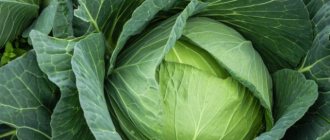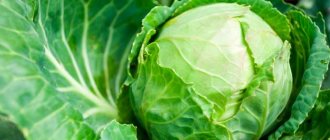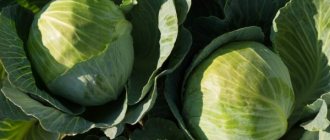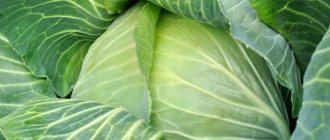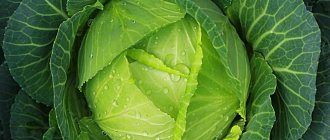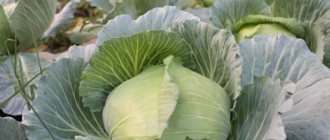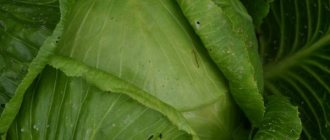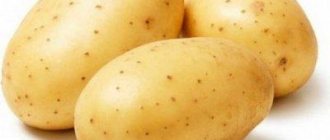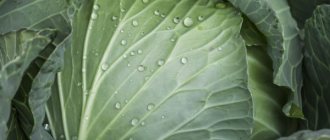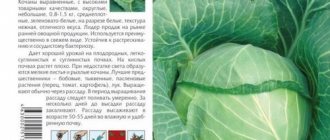Vegetable growing » Cabbage
0
1389
Article rating
Kira Stoletova
The cabbage variety Tochka has early ripening periods. The crop is characterized by the evenness of the forks, which makes it possible to transport them conveniently.
Characteristics of cabbage variety Tochka
Description and characteristics of the variety
White cabbage Tochka is grown throughout Russia: in the Central region, Siberia, the Urals and the North-West. This is a non-hybrid early ripening variety. The first heads are cut off 90–100 days after germination, mass yield of the crop begins after 105–115 days.
The leaves are green, slightly wavy, with a slight waxy coating, collected in a semi-raised rosette with a diameter of 45–70 cm. The outer stalk reaches 12 cm. The head is compact, weighing up to 1.5–2 kg, but small heads of cabbage from 700 g can be collected. The shape is rounded -cone-shaped. It reaches 17 cm in diameter.
The density of heads of cabbage is average or low; there are loose specimens that are poorly suited for transportation and sale.
In cross section, the head is yellowish-white. The pulp is without hard veins, tasty, tender, juicy. Used for preparing salads and dishes, stewing, and boiling. Not suitable for fermentation and long-term storage.
Benefit
It is very useful for children
Cabbage is a dietary vegetable that is recommended for various diseases as a dietary supplement.
It is used:
- for obesity
- excess cholesterol
- gallbladder diseases
- diabetes
- atherosclerosis and vascular diseases
- heart diseases
- some stomach diseases
- gout
Cabbage contains a lot of valuable and healthy fiber, vitamins A, C, vitamins B, K, U, proteins, and mineral salts.
It is very useful, even for healthy people, to drink juice from cabbage leaves.
One of the first medical recommendations for the use of this product concerned patients with stomach ulcers. And also for those who have gastritis.
All varieties of cabbage are very useful for dietary and therapeutic nutrition. But everyone has a different ratio of microelements and vitamins, which makes them useful in different cases.
For example, Savoy cabbage contains ascorbigen. This is a substance that, when broken down in the human body, inhibits the growth of cancer cells.
Cauliflower has many benefits over other types
It is absorbed better, therefore a larger percentage of nutrients enters the body. While regular white cabbage can cause bloating, this is not the case with cauliflower cabbage. It is gently digested and does not irritate the mucous membranes.
This is why cauliflower is most often used in baby food. But it is not recommended for gout. But the cauliflower is richer than the cabbage cabbage in terms of the percentage of proteins two times, vitamin C - three times.
Broccoli is rich in vitamin A (more than other types). This species also contains a substance that fights cancer cells. Broccoli seed sprouts are especially rich in this substance: 50 times more than cabbage itself.
Grapes: description of 20 varieties for growing in a temperate climate zone, features of care and propagation at home (Photo & Video) + Reviews
Growing and care
Cabbage requires good lighting. The optimal temperature is +17–25. When it gets cold, the beds are covered.
In the first weeks after transplantation, water frequently, but not in excess. Over time, they switch to watering a little less frequently, and during the ripening period, shortly before harvesting, they suspend irrigation. Use settled water and apply it at the root.
Loosen the soil after each watering or rain to a depth of 4–8 cm. Combine with weeding.
Due to the long outer stump, hilling is required to prevent the heads of cabbage from falling to one side. Hill up twice or thrice until the first lower leaves.
The variety is fed twice:
- 10 days after rooting - nitrogen fertilizer (mullein, chicken droppings, saltpeter, urea).
- At the beginning of the formation of heads or shortly before this, use potassium-phosphorus fertilizer (potassium sulfate, superphosphate).
Features of agricultural technology
As already noted, Tochka potentially implies high yields when grown in domestic spaces. It is possible to achieve significant indicators in this regard only if the culture is provided with proper care.
First of all, you should choose the right area for planting cabbage. This species is a light-loving species, so the site should not be shaded throughout the day. In addition, by the time the seedlings are transplanted into the beds, the air temperature should already be at least 16–17 degrees.
Also, special attention should be paid to the process of growing seedlings and further care of transplanted cabbage.
Growing seedlings
Sowing seeds of this variety for seedlings is carried out from mid-March to early April (specific dates are determined by the climate of the region). Moreover, the sowing of seeds is carried out both in separate cups and in common boxes. In the second case, seedlings must be picked over time.
Preparing and planting seeds
A soil mixture suitable for the variety can be purchased ready-made in the store. If desired, an alternative to this option can be preparing the soil mixture with your own hands. To do this, take the following components:
- 1 kg of turf soil (when collecting from the garden, avoid areas where any cruciferous vegetables previously grew);
- 1 kg of humus;
- 1 tablespoon of ash;
- a small amount of peat (optional).
It is recommended to pour boiling water over the entire volume of turf soil for disinfection. After this, the components are thoroughly mixed, and the finished composition is scattered into prepared containers.
The next step is seed preparation. Here the procedure involves the same algorithm as when planting other varieties of cabbage. The seeds are wrapped in a piece of gauze and immersed in water at a temperature of 50 degrees for 15–20 minutes. Then, without allowing the seeds to cool, the material is immediately immersed in cold water for a couple of minutes. Then the seeds are allowed to rest in damp gauze for 2 days.
Planting seeds is carried out according to the following instructions:
- The prepared mixture is poured into boxes in a layer of 4–6 cm.
- Then the soil is watered abundantly.
- In the box, furrows with a depth of 0.5-1 cm are made every 3 cm along the entire length.
- Seeds are placed in the grooves with a distance of 2 cm between them.
- The seeds are sprinkled with loose soil on top and sprayed with water from a spray bottle.
Important! After planting, the box is covered with film and set aside in a dry and bright place. In this case, you should choose a room that is well ventilated and the temperature in it is kept at 18–20 degrees.
Seedling care
If all the specified points are observed, seedlings appear in the box within 3–5 days. They should receive special care during this time. First of all, the room temperature is reduced to 15 degrees during the daytime. At night, it is advisable that it does not exceed 8–10 degrees.
Water the sprouts when the soil begins to dry out a little, but you should not allow the soil to dry out completely or become excessively moist. It is much easier to regulate the frequency and volume of watering plants if you periodically loosen the top layer of soil.
A prerequisite for growing strong seedlings is the timely application of fertilizers to the soil. Cabbage seedlings of the Tochka variety are fertilized three times:
Nitrate for fertilizing
- After about 1.5-2 weeks, the seedlings are picked, planted in separate containers. A week after this, the first feeding is carried out. To do this, use saltpeter (2 g), potassium fertilizer (2 g), superphosphate (4 g). The indicated volumes of each substance are diluted in 1 liter of water. This volume is enough to fertilize 50 seedlings.
- The soil is fertilized a second time 12–15 days after the first fertilizing. The components for the solution do not change, but the volumes of each of them per liter of water are doubled.
- The last time the plants are fed is 2–3 days before planting. To do this, use 8 g of potassium-based fertilizers, 3 g of nitrate and approximately 5 g of superphosphate. All this is dissolved in a liter of water.
Attention! The indicated liquid fertilizers are poured under the stem after preliminary thorough watering of the vegetation. This approach will avoid the appearance of burns on young plant roots.
The last, but no less important stage in growing seedlings is hardening. This procedure can significantly increase the survival rate of sprouts and increase their resistance to weather conditions. Hardening is carried out 10 days before the planned transplantation of vegetation. Moreover, it is implemented in 3 stages:
- In the first 2–3 days, in the room in which the boxes are located, open the window for 2–3 hours a day.
- Over the next 2–3 days, the boxes are taken out to the balcony, increasing the period of their stay there from 2 to 6–8 hours. Moreover, on the first day, all seedlings need to be covered with gauze so that they do not burn in the sun.
- From 6 days until the time of planting, seedlings are kept on the balcony around the clock.
It is worth noting that throughout the entire third stage of hardening the seedlings, they are not watered. Watering is carried out only before planting.
Transplantation into the ground
At the time of planting the grown seedlings, the soil temperature should already be 14–15 degrees. In addition, the air temperature should not fall below 17 degrees. If sharp drops are still visible, the plantings must be covered with film.
The main criterion for the readiness of seedlings to move to the garden bed is the appearance of 4–5 true leaves on the stem. In addition, it is desirable that the length of each plant already reaches 15 cm.
The site for planting is selected in the fall. At the same time, it is fertilized and dug up. Manure is used as fertilizer. It is added based on the calculation of half a bucket per square meter of area.
Manure for feeding
In spring, planting is carried out as follows:
- The designated area is leveled and weeds are removed from it.
- On fluffy soil, holes are dug based on a 60x40 pattern, where 60 cm is the width of the rows, and 40 cm is the distance between the bushes in the row. Warm, settled water is poured into the wells.
- The soil in the box is moistened generously with water 12 hours before transplanting. After this, the seedlings are taken out with a lump of earth and placed in a hole so that the root is located vertically down.
- The hole is filled to the top with earth, leaving a 1-2 cm depression under the top. It will help retain moisture during watering.
It is recommended to transfer seedlings to the garden bed in cloudy weather. If the weather outside is dry, then the landing is planned for the evening. At first, at lunchtime, the transplanted plants are covered with agrofibre to prevent the leaves from drying out.
Caring for cabbage Tochka
After transplanting the crop to a permanent place, the main aspects of caring for it undergo certain changes. At this stage of development, cabbage requires a special watering regime, individual fertilizing and other care procedures.
Watering
Tochka cabbage is quite demanding when it comes to watering, but you shouldn’t get too carried away in this regard, since excessive soil moisture leads to the development of diseases in the plant and cracking of the heads.
Particularly thorough watering is carried out in the first days after planting seedlings, as well as at the initial stage of the ovary of heads of cabbage. On average, such a crop is watered twice a week, and the liquid consumption per square meter of area is 11–13 liters.
It is worth noting that the vegetation is watered exclusively with water that has been settled and heated in the sun. In this case, the watering process itself is scheduled for the evening, when direct sunlight no longer hits the leaves of the plant.
To improve the passage of liquid to the roots, the top layer of soil is periodically loosened. At the same time, weeds are removed from the garden bed. Loosening is carried out 8–10 cm deep.
Top dressing
Feeding cabbage helps accelerate the growth of bushes and their more intensive development. But, as in the case of seedlings, fertilizers should be applied in a timely manner. As a rule, the soil is fed twice.
The first fertilizer is carried out 2-2.5 weeks after planting the seedlings. During this period, the plant especially needs nitrogen for growth. Therefore, liquid mullein is added to the soil, which is diluted with warm water, and the concentration is 0.5 liters of manure for every 10 liters of liquid.
If desired, you can also use ammonium nitrate, 20 g of which is diluted with 10 liters of liquid. Such solutions are poured under the root of the plant, being careful not to touch the foliage. Otherwise, aggressive nitrogen-containing substances can cause leaf burns. For regular watering, the latter solution is suitable, but in this case the volume of nitrate used is halved.
The second feeding is carried out 10–15 days after the first, using one of the following compositions:
- 100 g of chicken manure, diluted in 1.5 liters of settled water;
- 50 g of nitrophoska per 10 liters of water;
- 0.5 kg of compost, 1 liter of wood ash infusion, 10 liters of water;
- 1 kg of mullein per 10 liters of water.
During the second feeding, the volumes of applied fertilizers are increased. About a liter of solution is poured under each bush.
Pest Control
The point is quite susceptible to pest attacks. For each of them, individual means of prevention and control are provided:
- Cruciferous flea beetle. These small insects eat cabbage leaves down to the veins in a matter of days. To combat them, the drug Karbofos is used. Among the traditional methods, dusting leaves with wood ash is considered effective.
- Aphid. She does not bite into the leaves, but sucks the juices out of them. Karbofos is also suitable for pest control. In addition, an infusion made from tobacco gives a good effect.
- Cabbage fly. Clay talkers, which are used to treat the roots before transplanting, help in the fight against this insect. Of the chemicals, the most popular is Chlorophos.
Cabbage fly
Treatment of diseases
Of the known diseases, the Tochka variety is most susceptible to clubroot and downy mildew. In the case of the first disease, effective treatment is not provided. Infected bushes are removed from the garden bed, and the ground underneath them is sprinkled with ash, preventing spread.
In the second case, the diseased plant is treated with Fitosporin, diluting the product according to the instructions. Also, a certain effect is achieved by Bordeaux mixture, which is diluted with water in the proportion of 0.2 liters of substance per 10 liters of liquid.
Harvest
After planting the seedlings in the garden, it takes approximately 60 days for the forks to fully mature. All heads ripen almost simultaneously, so they are collected in 1–2 batches. At the same time, 2 weeks before harvesting, watering is stopped, and the harvesting itself is planned for a dry day and carried out in the morning.
This type of cabbage is not suitable for long-term storage. It is recommended to be consumed fresh or for preparing various dishes, but the crop withstands transportation, which allows the crops to be used for sale.
Tochka cabbage is one of the early white cabbage varieties. This variety of vegetable is excellent for fresh consumption, it has a good taste and a composition rich in vitamins. In addition, for early ripening varieties, Tochka shows extremely high yields. However, large crop yields can be obtained only if the basic rules for growing seedlings and caring for adult plants are followed.
Reviews from summer residents
Valentina Mikhailovna, Rostov, 46 years old.
We have already tried a lot of early ripening varieties. We mainly grow early ripening varieties, as late and medium varieties are tough. In 2017, we purchased seeds of the Tochka variety from. I’ll say right away that the germination rate was excellent and it didn’t require much care. During the entire growing season, we only watered it 2 times a week and periodically collected caterpillars, since this is the only way caterpillars “eat” cabbage.
Valentin Igorevich, Voronezh, 53 years old.
I like the point for its productivity and good immunity. I’ve been growing it for several years now and haven’t suffered from a single disease. Seeds were always bought from Russian Cold. Germination is around 95-100%, that is, very high. Another plus is that the seeds are cheap, about 20-30 rubles per pack. After planting the seeds, I cut the first heads of cabbage within 100-105 days. The heads of cabbage are dense. Many on the Internet write that the head of cabbage is loose, but this is not true. I can tell you from experience that there are no loose heads of cabbage, they are always dense. The heads of cabbage themselves are small in size, up to 1.2 kg, which is ideal for one-time consumption. If you ask me whether I recommend Tochka as the main early-ripening cabbage variety, then yes, I definitely recommend it.
